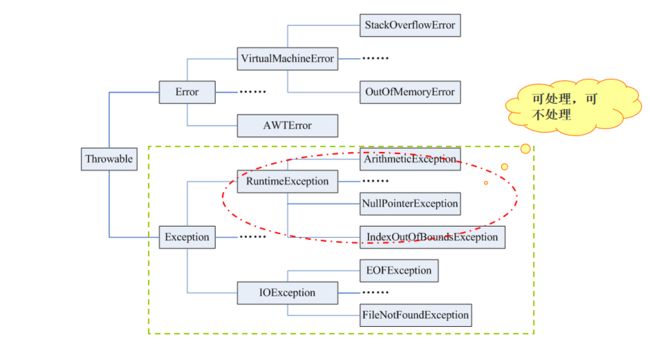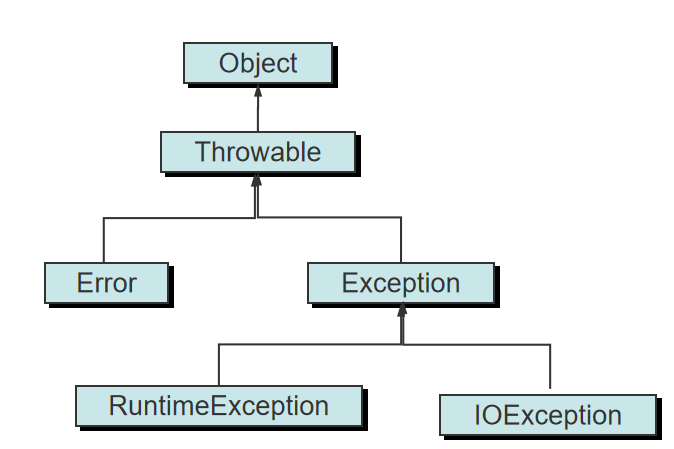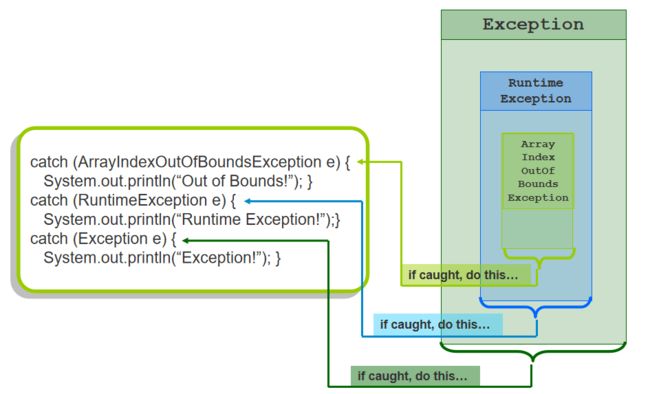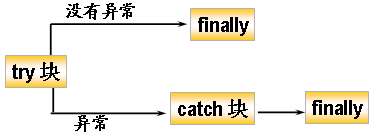异常简介
- 异常的定义
- 运行期间出现的错误,而不是编译时的语法错误
- 例如,
- 打开一个不存在的文件
- 网络连接中断
- 操作数组越界等
- 异常的定义
- 示 例 数组越界异常
public class excption_sample {
public static void main(String args[ ]){
int i = 0;
String greetings[ ] = {"Hello World",
"Hello Dingdang",
"Hello Kitty"};
while(i<4){
System.out.println(greetings[i]);
i++;
}
}
}
异常类的继承关系
- 异常的继承树
-
异常类的体系结构
-
Object 类的直接子类Throwable描述了所有被虚拟机抛出的非正常状况。一般情况下很少用Throwable,而是使用它的两个子类Error、Exception。
- Error类特指应用程序在运行期间发生的严重错误。如:虚拟机内存用尽、堆栈溢出等等。一般情况下这种错误都是灾难性的,所以没有必要使用异常处理机制处理Error。
- Exception类有几十个子类,描述了不同类型的异常,其中:
- 以RuntimeException为代表的一些类,称为非检查性异常(unchecked Exception),
- 以IOException为代表的一些类为检查性异常(checked Exception)。所谓的检查和非检查是指编译器在编译时是否检查。如果代码中存在检查性异常,必须进行异常处理,否则编译时不能通过;而非检查性异常编译时不进行检查,到运行时才会显现。
-
异常类型
-
检查性异常(checked exception)
- 若系统运行时可能产生该类异常,则必须写出相应的处理代码,否则无法通过编译
- 非RuntimeException异常
-
非检查性异常(unchecked exception)
- 若系统运行时可能产生该类异常,则不必在程序中声明对该类异常的处理,就可以编译执行
- RuntimeException:运行时异常
-
Java为何分别处理这两类异常?
一般我们不在 代码中处理非检查性异常,这类异常都在运行时抛出。原因主要是由于程序员经验不足或是思维不缜密造成。如:数组越界异常(ArrayIndexOutOfBoundsException)、整数除以0异常(ArithmeticException)等,这类异常其实就是我们通常说的bug。所以,这类异常应通过反复测试尽量避免,而不应该靠异常处理机制来解决。
检查性异常不同,就算程序员再有经验,也是难以避免。如:用户连接数据库的异常(SQLException),如果是由于数据库服务器没有启动或是网络中断引起的,我们程序员是无法避免的。又如:程序要读取光盘中的文件,而用户忘记插入光盘,此时则抛出文件没找到异常(FileNotFoundException),程序员也无法避免。
综上,异常处理机制主要处理检查性异常而不是非检查性异常和Error。
| 非检查性异常 | 说明 |
|---|---|
| RuntimeException | java.lang包中多数异常的基类 |
| ArithmeticException | 算术错误,如除以 0 |
| IllegalArgumentException | 方法收到非法参数 |
| ArrayIndexOutOfBoundsException | 数组下标出界 |
| NullPointerException | 试图访问 null 对象引用 |
| 检查性异常 | 说明 |
|---|---|
| ClassNotFoundException | 无法找到想要创建对象的类文件 |
| IOException | I/O 异常的根类 |
| FileNotFoundException | 不能找到文件 |
| EOFException | 文件结束 |
| IllegalAccessException | 对类的访问被拒绝 |
| NoSuchMethodException | 请求的方法不存在 |
| InterruptedException | 线程中断 |
异常处理机制
- 异常的处理过程
在Java程序执行过程中如果出现异常事件,系统会发出异常报告,这时系统将生成一个异常类对象,异常类对象封装了异常事件的信息并将其提交给Java运行时系统
-
Java 中可用于处理异常的两种方式:
- 自行处理:可能引发异常的语句封入在 try 块内,而处理异常的相应语句则封入在 catch 块内。
- 回避异常:在方法声明中包含 throws 子句,通知潜在调用者,如果发生了异常,必须由调用者处理。
try…catch语句
示例 Exception_sample_1.java
public class excption_sample {
public static void main(String args[ ]){
int i = 0;
String greetings[ ] = {"Hello World",
"Hello Dingdang",
"Hello Kitty"};
try{ //try{}表示可能发生异常的语句
while(i<4){
System.out.println(greetings[i]);
i++;
}
}catch(ArrayIndexOutOfBoundsException e){//catch( )内的参数异常类对象的声明
System.out.println(“数组越界异常”);//catch{}内的语句是对异常的处理
}
}
}
- catch块,是用来捕获并处理try块抛出的异常的代码块。没有try块,catch块不能单独存在。我们可以有多个catch块,以捕获不同类型的异常
- 如果程序抛出多个不同类型的异常,我们需要多个catch()语句来处理。
- 和特殊异常类相关联的catch()块必须写在和普通异常类相关联的catch()之前。
- try{…}和catch( ){…}之间不可以添加任何代码
- 每次try块有异常抛出,系统会试着从上到下往每个catch块中传参,直到遇到一个类型匹配的catch块为止。
- 如上示例中最后一个catch块中的形参为Exception类型,它是所有异常类的父类,任何异常都可以传参到该块中,该块可以处理任何类型的异常。因此,这个catch块只能放到最后面,否则所有的异常都被它处理了,其他的catch块就不能分门别类的起作用了。
- 如果编写过程中我们违背了这一点,会产生编译错误:
exception java.io.ArrayOutOfBoundsException has already bean caught
- 一般一个catch块中是专门处理异常的代码,在程序中这里还可以是记录日志的语句,当发生异常时记录该日志,无异常时将不会记录。
异常处理机制——Java7特性
- catch表达式调整
- JDK 7中,单个catch块可以处理多个异常类型
try {
......
} catch(ClassNotFoundException|SQLException ex) {
ex.printStackTrace();
}
- catch表达式调整
- 这种用法是不包括异常的子类型的。比如说,下面这个多个异常的捕获语句就会抛出编译错误:
try {
......
} catch (FileNotFoundException | IOException ex) {
ex.printStackTrace();
}
- finally 语句
- finally语句放在try …catch语句后
- fianlly语句中的代码块不管异常是否被捕获总是要执行
- 通常在finally语句中可以进行资源的清除操作,如:关闭打开文件、删除临时文件
- 对应finally代码中的语句,即使try代码块和catch代码块中使用了return语句退出当前方法或般若break跳出某个循环,相关的finally代码块都有执行。
- 当try或catch代码块中执行了System.exit(0)时,finally代码块中的内容不被执行
catch (ArrayIndexOutOfBoundsException e) {
System.out.println(“Out of Bounds!”);
return;
}
catch (RuntimeException e) {
System.out.println(“Runtime Exception!”);}
catch (Exception e) {
System.out.println(“Exception!”);
}finally{
System.out.println("program is running into finally!");//无论是否捕获异常,系统都会执行该语句
}
- throws关键字
- 如果一个方法中的语句执行时可能生成某种异常,但是并不能确定如何处理,则可以在程序所在的函数声明后,使用throws关键字抛出异常
class ThrowsDemo{
public void proc( ) throws IOException{
System.out.println("inside proc");
}
}
- 位置:函数参数列表的后面
- throws关键字后面,可以跟多个异常,中间用逗号分割
- throws关键字抛出的异常,由调用该函数的函数处理。
- 方法中如果用throws关键字抛出:
- 非检查性异常:上一级去除异常,直到不抛出异常;
- 检查性异常
- 在调用该函数内try-catch,把异常处理掉。那么不往上一级抛出异常,程序正常执行,上一级方法并不知道曾经产生异常。
- 用throws声明方法抛出异常,不进行处理。谁调用谁负责处理
- 覆盖方法抛出异常时,可以抛出与被覆盖方法相同的异常或者被覆盖方法异常的子类异常。
public class ThrowTest
{
public void createFile(String path) throws IOException{
File f= new File(path);
f.createNewFile();
}
public static void main(String[] args){
ThrowTest tt = new ThrowTest();
try{
tt.createFile("c:/abc.txt");
}catch(IOException ex){
ex.printStackTrace();
}
}
}
- throw语句
- 异常是通过关键字 throw 抛出,程序可以用throw语句引发明确的异常。如:
void doA() throws Exception1 {
try {
.....
}catch(Exception1 e){
throw e;
}catch(Exception2 e){
System.out.println("出错了");
}
}
- throw语句用在方法体内,表示抛出异常,由方法体内的语句处理。不能单独使用,要么和try.. catch…一起使用,要么和throws一起使用。
- throw语句的操作数一定是Throwable类类型或Throwable子类类型的一个对象
public class ThrowTest
{
public void createFile(String path) throws IOException{
File f= new File(path);
try{
f.createNewFile();
}catch(IOException ie){
ie.printStackTrace();
throw ie; //再次抛出
}
}
public static void main(String[] args){
ThrowTest tt = new ThrowTest();
try{
tt.createFile("c:/abc.txt");
}catch(IOException ex){
ex.printStackTrace();
}
}
}
示例代码:
package 异常的处理;
public class TestExceptionHandler {
public int sum(int a,int b) {
return a + b;
}
public static void main(String[] args) throws ClassNotFoundException {//2.消积处理
//模拟异常,看怎么处理?
//2.消积处理:异常抛出虚拟机,程序终止
Class.forName("java.a.Date");
//1.积极处理:程序继续执行完毕
// try {
// Class.forName("java.a.Date");
// } catch (Exception e) {
// e.printStackTrace();
// }
// for (int i = 0; i < 100; i++) {
// System.out.println(i);
// }
}
}
package 异常的处理;
import java.io.File;
import java.io.FileInputStream;
import java.io.FileNotFoundException;
import java.io.IOException;
public class TestExceptionHandler2 {
public static void main(String[] args){
File file = new File("e:\\HelloWorld.java");
FileInputStream is = null;
try {
is = new FileInputStream(file);
int result = is.read();//根据提示选择clause to surrounding by
Class.forName("java.a.b");
// } catch (ClassNotFoundException | IOException e) {//Java7对catch的改写,可以多个异常同时写
// e.printStackTrace();
} catch (FileNotFoundException e) {
System.out.println("a");
e.printStackTrace();
} catch (ClassNotFoundException e1) {
e1.printStackTrace();
} catch (IOException e) {
System.out.println("b");
e.printStackTrace();
//1.finally语句块有什么 作用?
// 用于释放资源,即使代码抛出异常,
// finally语句块中的代码也会执行
}finally {
try {
is.close();
} catch (IOException e) {
e.printStackTrace();
}
}
//2.final finalize finally 有什么区别?
/**
* final 修饰的类不能有子类
* 修饰的方法不能重写
* 修饰的变量不能重新赋值,叫常量
* finalize:如果发现有垃圾对象的话就会调用finalize()方法,释放它所占用的内存
* finally: 确保我们程序当中有些释放资源的方法能够执行,
* 一般跟在try catch语句块后面
*/
}
}
package 异常的处理;
import java.io.File;
import java.io.FileInputStream;
public class TestRuntimeException {
public static void main(String[] args) throws Exception {//消积处理
// String a = null;
// System.out.println(a.length());//java.lang.NullPointerException
File file = new File("e:\\HelloWorld.java");
// try {
// FileInputStream is = new FileInputStream(file);
//
// int result = is.read();
// } catch (Exception e) {
// e.printStackTrace();
// }//积极处理
FileInputStream is = new FileInputStream(file);
int result = is.read();
}
}
package 异常的处理;
public class Test {
public static void main(String[] args) {
// double p = "";//这是语法错误,称不上异常
/**
* 异常:
* 代码运行期间出现的错误
* 打开一个不存在的文件
* 网络连接中断
* 操作数组越界等
*/
for (int i = 0; i < 10; i++) {
System.out.println(i);
}
// int b = 0;
// if(b != 0) {
// int a = 10 / b;
// }
try {
Class.forName("java.a.b");
System.out.println("a");
} catch (Exception e) {
System.out.println("b");
e.printStackTrace();
}finally {
System.out.println("d");
}
System.out.println("c");
for (int i = 0; i < 10; i++) {
System.out.println("i: " + i);
}
}
}
以上就是我关于 Java-自定义异常类 知识点的整理与总结的全部内容,另附源码
==================================================================
分割线
==================================================================
博主为咯学编程:父母不同意学编程,现已断绝关系;恋人不同意学编程,现已分手;亲戚不同意学编程,现已断绝来往;老板不同意学编程,现已失业三十年。。。。。。如果此博文有帮到你欢迎打赏,金额不限。。。




